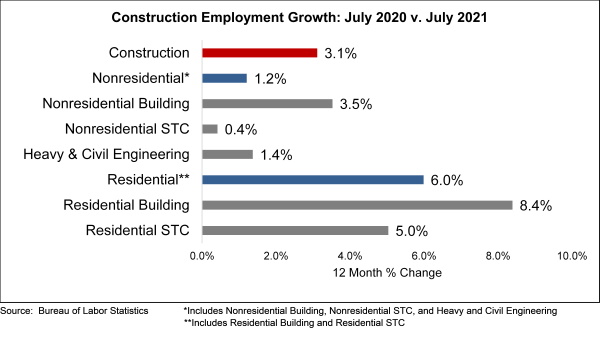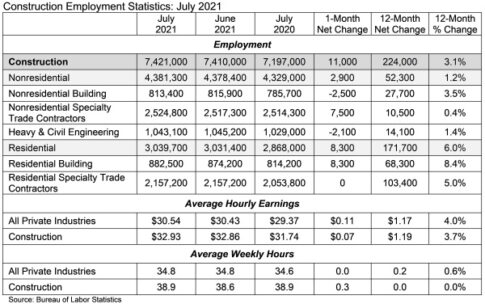
The nation’s construction industry added 11,000 jobs on net in July, according to an Associated Builders and Contractors analysis of data released by the U.S. Bureau of Labor Statistics. Overall, the industry has recovered 886,000 (79.6%) of the jobs lost during earlier stages of the pandemic.
Nonresidential construction employment expanded by 2,900 positions on net, though more than 100% of the gains were among nonresidential specialty trade contractors, which added 7,500 jobs. The nonresidential building (-2,500) and heavy and civil engineering (-2,100) segments both lost jobs in July.
The construction unemployment rate fell to 6.1% in July. Unemployment across all industries declined from 5.9% in June to 5.4% last month.
“While it is easy to identify numerous challenges in the current economic environment, including inflation, input shortages and the delta variant, there is one driving factor that countervails them all and then some,” said ABC Chief Economist Anirban Basu. “That factor is liquidity. With so much money working its way through financial systems, including liquidity injected on a monthly basis by the Federal Reserve, America is in rapid recovery mode with interest rates remaining at absurdly low levels.
 “Some of the capital that investors seek to deploy is invested in real estate, which translates into additional construction work,” said Basu. “While construction of new structures remains suppressed in a number of segments like lodging and office due to the dislocating effects of the COVID-induced downturn, there is considerable work underway in terms of modernizing existing structures. That helps explain why nonresidential specialty trade contractors added thousands of jobs last month, while general contractors did not.
“Some of the capital that investors seek to deploy is invested in real estate, which translates into additional construction work,” said Basu. “While construction of new structures remains suppressed in a number of segments like lodging and office due to the dislocating effects of the COVID-induced downturn, there is considerable work underway in terms of modernizing existing structures. That helps explain why nonresidential specialty trade contractors added thousands of jobs last month, while general contractors did not.
“Evidence of ongoing rapid recovery is consistent with the upbeat assessments contractors have put forth in ABC’s Construction Confidence Index regarding revenue, staffing and profit margin prospects over the balance of 2021,” said Basu. “Indeed, there is evidence that the lack of growth in nonresidential construction spending observed in recent months is due to supply constraints as opposed to a lack of demand for construction services. Some contractors are noticing that there are fewer bidders on emerging projects, suggesting that many contractors can no longer pursue additional work.”



 Join our thriving community of 70,000+ superintendents and trade professionals on LinkedIn!
Join our thriving community of 70,000+ superintendents and trade professionals on LinkedIn! Search our job board for your next opportunity, or post an opening within your company.
Search our job board for your next opportunity, or post an opening within your company. Subscribe to our monthly
Construction Superintendent eNewsletter and stay current.
Subscribe to our monthly
Construction Superintendent eNewsletter and stay current.